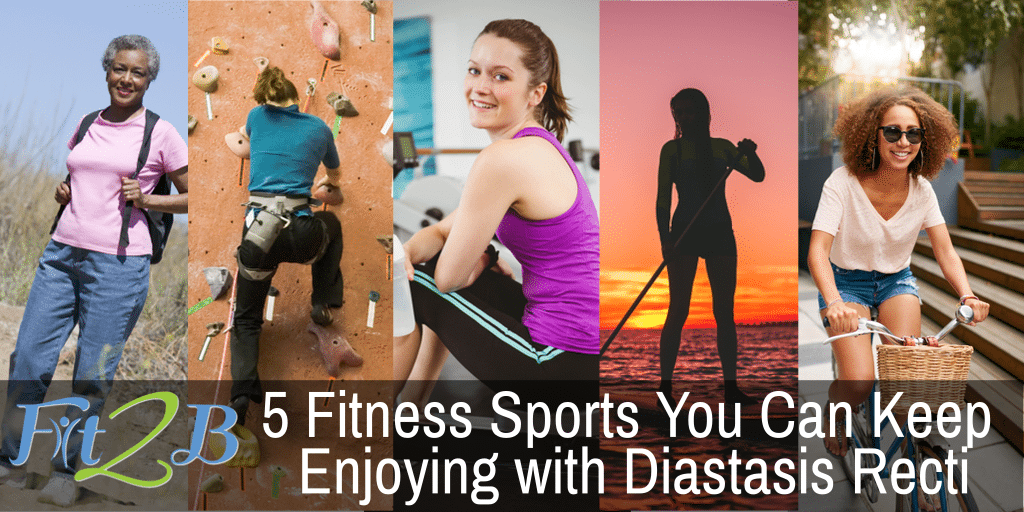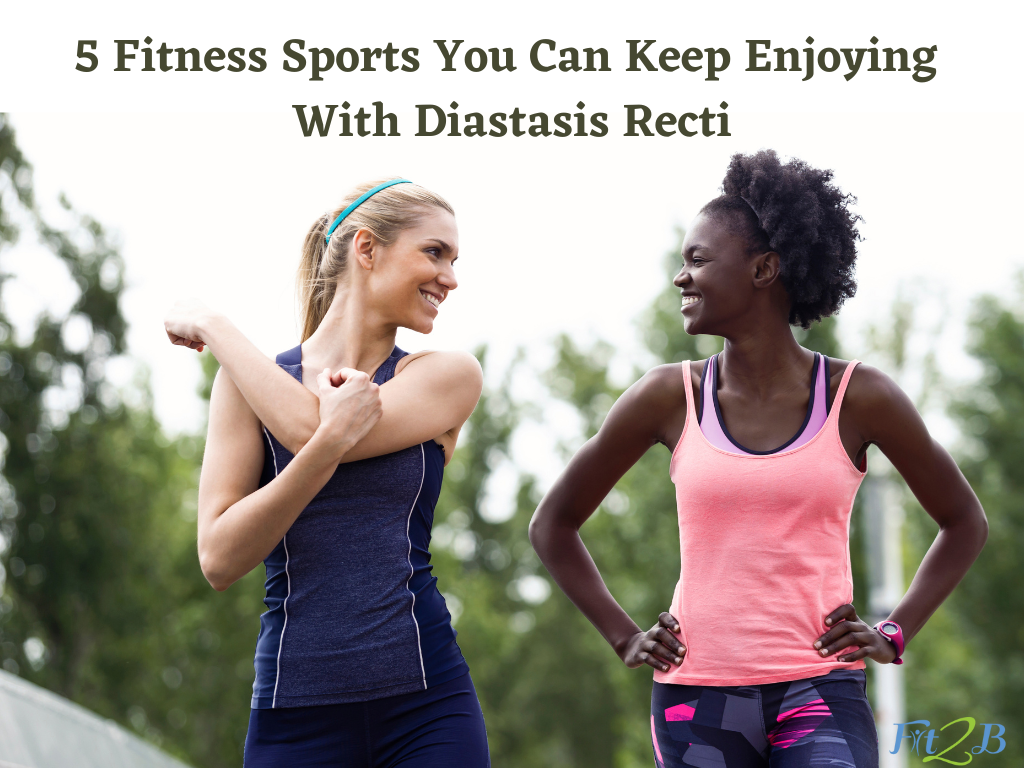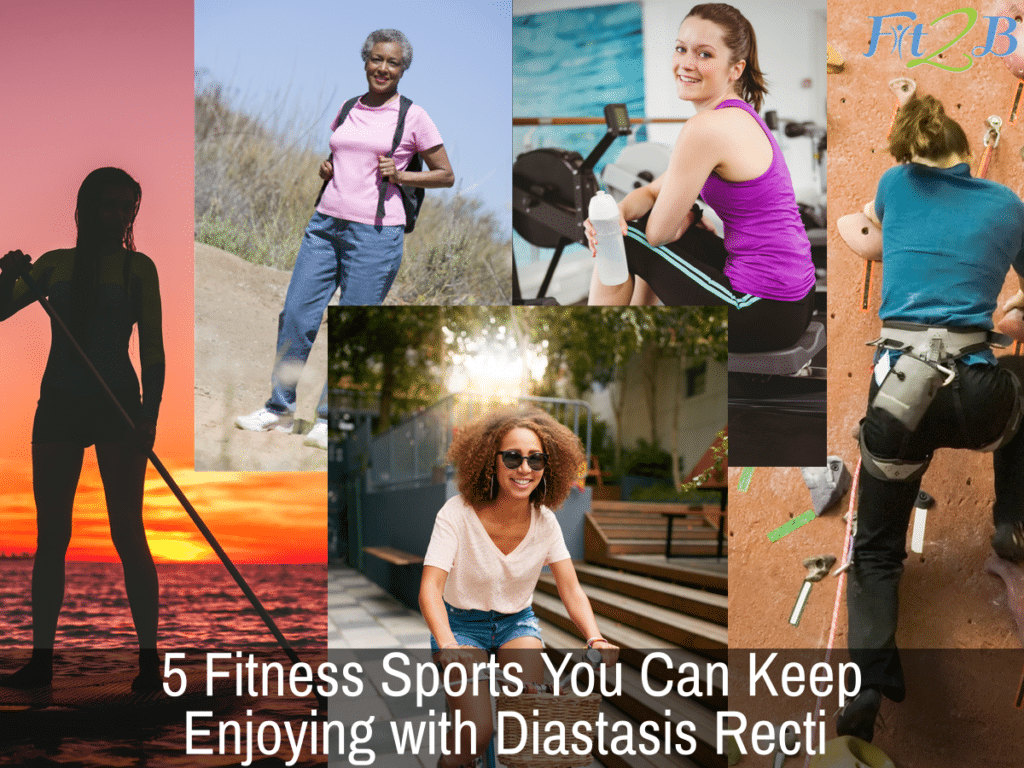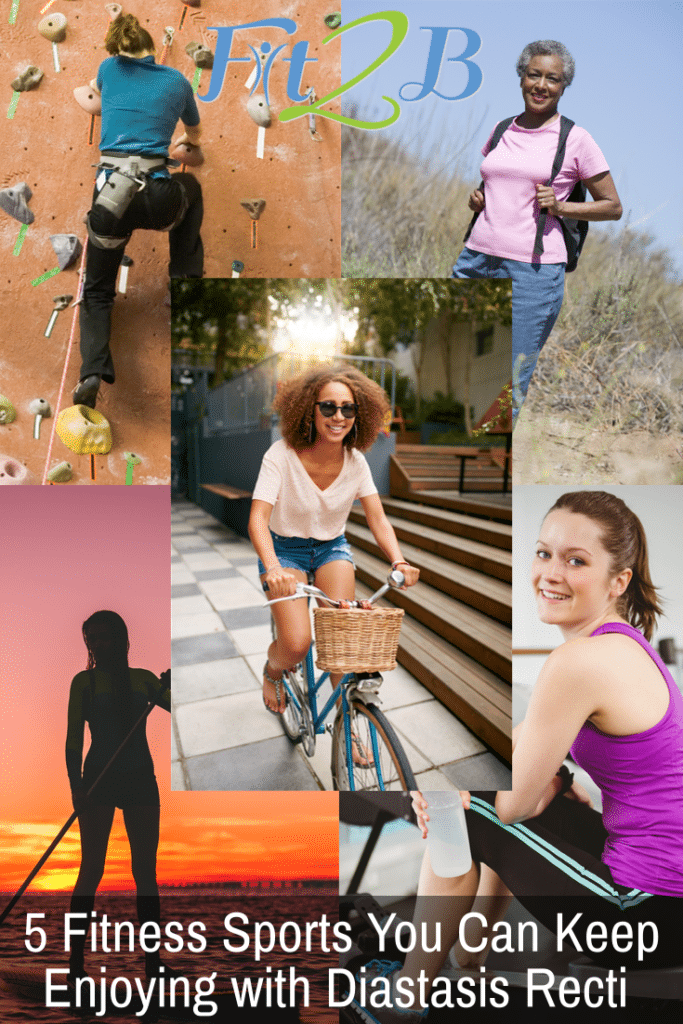Blog
5 Fitness Sports You Can Keep Enjoying With Diastasis Recti
 If you have diastasis recti, can you keep paddleboarding? Rowing? Climbing? We field a lot of questions about fitness sports people can enjoy with diastasis recti. While some see a diagnosis of diastasis recti as a time to stop moving completely, here at Fit2B we believe that once you have done core rehab with a women’s health specialist, your continued recovery is a time to dial in your strategy and ease back into doing what you love!
If you have diastasis recti, can you keep paddleboarding? Rowing? Climbing? We field a lot of questions about fitness sports people can enjoy with diastasis recti. While some see a diagnosis of diastasis recti as a time to stop moving completely, here at Fit2B we believe that once you have done core rehab with a women’s health specialist, your continued recovery is a time to dial in your strategy and ease back into doing what you love!
The most common five physical activities I get asked about in our private member forum are indoor rowing, riding a bicycle, running, rock climbing, stand up paddle boarding, and walking or hiking. I’ve gathered some awesome tips for doing these things safely, and I figured you’d enjoy seeing them all in one place here on the blog.
Indoor Rowing Machine
“Rowing can be done safely while healing,” says Beth Jones, restorative exercise specialist, founder of Mid-Life Moms Adventure Club, and contributor to our Experts in Diastasis Recti ecourse. According to her, the three basic considerations are these:
1) no rib thrusting at any point,
2) engagement before the drive, and
3) limit layback as needed for engagement.
It’s important to keep that core engagement, so if you lose that or see/feel any doming/pooching then you’ve gone too far with your leanback. You might feel like you’re needing stay a bit more upright for awhile. She says to make sure to you are engaging your pelvic floor and core before the drive. “I use the ‘blow before you go’ technique myself.” Jones advises. “Finally, keep that pelvis untucked and your ribs dropped on the recovery. Let the erg [machine] pull you back to the drive position instead of sticking your chest out and using your legs to pull you up.”
Stand Up Paddle Board (SUP)
It was Kelly Dean herself, founder of The Tummy Team and core rehab specialist, who taught me how to paddleboard. She met me at LaCamas Lake with two paddle boards in the back of her truck, and we spent a lot of time laughing at my leaning and wobbling while I got the hang of it. “Start on your knees, spreading them to shoulder width right in the middle of your board.” She coached me, my core, my alignment. “Stay elongated. Keep your shoulders relaxed. Don’t twist at your tummy. Let your arms do the work.” She showed me how to rock back into a squat to stand—a move I went on to teach in the Get Up {And Down} routine on Fit2B—and soon I was paddling around with ease. Now I have my own board and take it out all the time every summer.
Indoor Rock Climbing
It’s all in the hips or, more specifically, the pelvis. I had a boyfriend who was an avid climber in high school, and I took a rock climbing class in college. A lot of climbing motions have the legs wide, toes out, butt tucked up against the rock in what is essentially an asymmetric squat. Another common repetitive position is lunge-like or the equivalent of a gigantic box step-up with turned-out toes. The pelvic floor muscle group is the base of your core, and these positions would all be very challenging to someone with prolapse or incontinence. The #externalrotation of the hips under load + hips pressed (butt tucked) against the wall are all non-optimal positions for a compromised core, but that doesn’t mean you can’t do this activity. It means that if you’re noticing an increase in symptoms, you need to assess your strategy, make a plan, and then apply it to smaller climbs. Then re-approach harder climbs with those strategies well set. A few of those strategies might include exhaling to engage during each transition, choosing narrower foot positions (which can feel less stable and more challenging to the rest of your body) and also keeping your pelvis more neutral even as you keep your hips close to the rock. Then gradually progress those strategies to harder climbs with more challenging body positions. Click HERE to read a post I wrote about this on our Instagram and give us a follow there.
Walking & Hiking
While many don’t see walking as a major fitness activity or sport, hiking is a popular pastime and race-walking is an officially recognized Olympic sport. Going for a casual stroll might feel easy, but your alignment and breathing techniques matter during all motions. Kelly Dean from the Tummy Team says, “Eyes on the horizon!” Keeping your eyes on the horizon and your ribs centered over your pelvis is key. The heel strike and full hip extension also matter a lot. If you’re interested in race walking (which can burn more calories than jogging) take a peek at this article about my experience with walking my first half marathon, and also check out our 6-week training video ecourse: Walking As A Workout!
Bicycling
Raise your handlebars and get a granny seat … You know, those really wide cushy seats that support your whole booty? Just for this season of recovery, extra support in all the places is key. Most bike seats are designed to be narrow and hit right at your pubic bone and tailbone, but “Biker’s Butt” is a real issue. Nerve compression in that delicate area can leave you squirming, numb, chafed, pinched, and hunching to avoid the discomfort. We need to sit tall, so you also want to raise your handlebars to a point where you don’t have to lean forward to hold them. Forward leaning creates more pressure on tender tummies. Being able to stack your ribs over your hips is not only easier on your diastasis recti, but it also make things easier on your arms and allows for more comfortable hip flexion. You’ll be able to raise your knees better, see what’s ahead of you, breathe deeper, and ride taller.
For diastasis-aware and pelvic floor-friendly running tips, read this!
Here at Fit2B, we’re pretty passionate about getting you back to doing what you love. What activities do you enjoy doing, but you’re not sure if they’re okay to do while healing your core? Is there something you used to enjoy or something you’d like to try, but you’d like some advice on how to proceed?
Leave a comment with your question about any activity, and we’ll do our best to get you the information you’re looking for.
If you want access to over 200 home exercise videos, click here to learn more about membership to Fit2B Studio today!




I was just diagonal with DR. I’m 55 and my
Children who wore born caection are
29 and 25. I was also told proper excerciae would avoid the growing g of the DR. It is ever to late to start, I know know why my excercise made my tummy bigger and
Not smaller, planks and crunches and sit-ups are bad for me!
Will the fit bit program help this late in the game?
I can’t speak to the fit bit program (although a lot of our members have those) but I can speak to Fit2B and our track record with helping people return to fitness while they sort their cores. If our workouts don’t help, we are linked to an amazing online rehab program that does wonders! It’s never too late to start. I’ve witnessed the widest DR gaps that have hung around for years suddenly snap shut in a matter of weeks. You can do this!
Pingback: Exercising & Your Breasts | Fit2B Studio
Hi I have been diagnosed with DR after having my son 9 weeks ago. I was planning on returning to my taekwondo training, I’ve been out of training for about 16 months, however a lot of the kicking requires good core strength. Will a martial art help or hinder my recovery please?
Hi Leah, is there a way for you to return to your martial art slowly and progressively? Do they include a lot of focused “ab work” in the class like crunches and situps? I’d love for every mama to see a core rehab specialist soon after birth before returning to fitness, but that’s not always possible. Have you seen our Postnatal Fitness Program? Our workouts are designed to help you make a safe return to fitness, and we collaborate with PT’s to be sure they are in line with therapy.
I had my 7th child 7 months ago and was diagnosed with DR. I am wanting to get in shape and fix my DR, I can’t wait to start your program! I have an Ab Circle Pro that I would like to start using again but am afraid it will make my DR worse. Can you tell me if it will help or hinder my DR?
Hello, I have a small gap-3 years post partum. I do a lot of road biking which gives me awful back pain. Should I stop doing road biking? I have to get down low? Also is there anything I can buy to support my core whilst riding? Thank you.
Great questions, Sophie. You could consider wearing a Fitsplint while riding. That’s a brand of rehab splint for the abs that is designed by an athlete mama for athlete mamas! I like to the Fitsplint here > fit2b.us/splinting
Also, if there’s a way to elongate your torso and avoid hunching into that classic “biker’s back” position, that will help your belly as well. Being in a semi-crunch position while in face-down “prone” position can be hard on sensitive fascia. If you can shift your handlebars a little bit further away or raise them a smidge, that will help a lot!
Hi Beth,
I have been doing DR exercises for about 1 month like
1. Posterior belt tilt
2. Posterior belt tilt with march
3. Bridge pose
4. Side planks
Will the above ones are enough to close my gap (which is 3.5fingers seperated).
And how to ensure that i am moving in a right path
Hi, closing a DR is more than doing specific exercises. If you do your exercises right, but you aren’t getting enough rest, good nutrition, and practicing good alignment throughout your day – or your genetics leave you with poor connective tissue – it may still remain open a little or a lot. Restoring function to your DR is a long game with many pieces. Fit2B offers LOTS of exercises with strategies for helping with your DR, and this is important because your core needs to be challenged with new things to truly get stronger.
Hey Beth,
I am doing transverse abdominis exercises like the ones listed above (marching, bridges, side planks, leg slides) and would like to know if sitting incorrectly puts a strain on the delicate fascia area. My living room furniture (recliner, couch, rocking chair with ottoman) leaves my ribs unstacked and I cannot sit up straight in it. The same goes for the sofa. I feel like sitting on the furniture can be making the pooch more apparent. Any suggestions on proper sitting and posture and how to adjust if the seats are not supportive in the lumbar area?
Pillows are my friend. Reclining isn’t “wrong,” but you want to be supporting your body so that you’re not jutting your head forward or caving in your lower back. This is your excuse to buy some cute couch pillows to toss around + use for lumbar/neck support 🙂
Hi Beth – I am a 62 year old man. I developed DR about 10 years ago due to an umbilical hernia. The hernia was repaired a while ago, but the DR remains. I have recently started cycling (about 50 miles a week currently).
Will cycling help reverse my DR?
Depends on how you do it! Many cyclists hunch over which bulges the belly and compresses the spine. If you use a good seat that doesn’t mess with your pelvic floor muscles AND set up your bike to sit tall with good, elongated posture then that will take pressure off your belly. Have you ever done physical therapy in person with a DR specialist?
I would like to get back into inline skating/rollerblading with my daughter. Not racing, just normal recreational use. Is there anything that I need to be especially careful of or any reasons that I should avoid rollerblading while I work on healing my DR? Thank you!
Oh, I love skating!! If you’re just doing it recreationally, then you’ll stay upright (standing tall) and not lean over a lot which is good. If and when you do lean over to get your speed going faster, just be mindful to keep your torso long, navel engaged about 25% inward toward your spine, eyes on the horizon.
I developed DR after microscopic prostate surgery. I am 72 and have been walking 18 holes of golf 5 days a week for 9 years. Over the past year I have been experiencing pain in lower back and hips. Just learned what DR was at my recent check up. Should I continue golf while doing DR exercises?
Were you offered core rehab after your surgery or at your recent checkup? I highly recommend that you look into the mens program with The Tummy Team. You can google them online and find what they offer. They’re amazing with online core rehab!
I would like to know if you can ride a recumbent trike with Diastasis Recti)?
Yes, for sure!